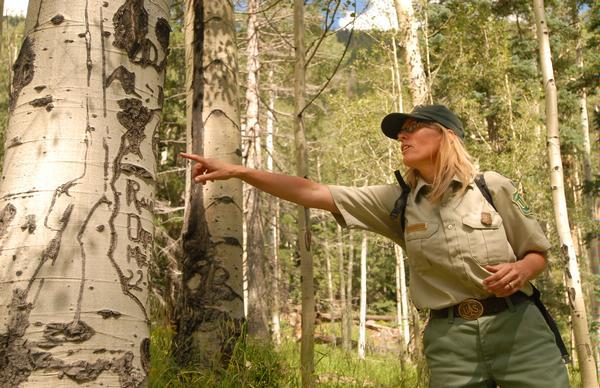 Special to the Daily Sun
Special to the Daily Sun
Monday, August 25, 2008
When Santiago Parra carved his name and the date, 1970, into an aspen tree on the Inner Basin Trail, he marked the end of an era. Parra made his lines thin and neat. As the tree grew and stretched, his marker would remain attractive, legible and a witness to his having herded sheep near Lockett Meadow.
The carvings, made solely on aspens, are called dendroglyphs. This historical graffiti mingles with contemporary proclamations of love. Though there are scores of significant carvings, one wouldn’t notice them for the sheer number of marks on the trees along this popular trail. Forest Ranger Heidi Strickfaden, who led an interpretive hike Saturday as a partnership event between the U.S. Forest Service and the National Park Service, said, “The carvings are important to ethnologists because we can track the Basque life in this area. They are like a ledger for a hotel.”
The etchings give names, dates, home territory and even pictures to tell us who passed this way. Who were these Basque sheepherders and how did they end up in Northern Arizona?
DISPERSED TO THE NEW WORLD
The Basque are thought to be the original European peoples. This ethnic group chiefly inhabits a region that covers north central Spain and southwestern France. Their language resembles no other European language, and their ethnic ties and culture are as fiercely defended today as throughout their past.
Tradition gave all property to the eldest son, leaving the other males in a family to find land as they could. By the 1700’s, there was no available land left in France or Spain. This forced men to seek their fortunes elsewhere in the world. They joined the Merchant Marines in large numbers, but their history of migration had begun two centuries earlier — a Basque crew sailed Columbus to the New World.
In the 1830s, Argentina created a Basque influx through their needs for a cheap labor source. These Basque were illiterate, so they were introduced to the sheep industry. Later, the Gold Rush lured many to California, but the proposition didn’t pan out and the Basque quickly reverted to their newest trade, sheepherding. They moved throughout the West and signed on with ranchers to run sheep on the public lands around Flagstaff.
A strong Basque presence in Flagstaff led to the opening of a Basque House, run for and by this ethnic work force. Up to 60 men would dine at tables each night throughout the winter season.
The work, difficult and lonely, was despised by others. The men saw only sheep, the occasional logger or hunter, and the camp tender who delivered supplies by wagon. Without a means of communication or record, these uneducated men turned to their simple tools to create art.
OF RIFLES AND WOMEN
The trees tell their story. Elme Baca came out from Los Angeles in 1934. Abierrtu Urrutia created a showy double circle for each year he worked. One man listed his sheep stock at 41. The men were paid in ewes to run sheep, and as their personal herd grew into some wealth, their goal was to return to their homes and marry.
Tools, such as rifles and hatchets, featured strongly, but the longing for a woman won out as herders shaped figures of their abandoned desire into innumerable forms. The 1930s era of modern art is also found in Picasso-like styling attributed to the Basque heritage artist.
Mexican and Peruvian herders joined the trade, and carvings began to include religious symbols, churches and dramatic portraits. The aspens chart their 100-year history.
So, get off the beaten path and search, but respect these historical finds.
“These people spent their lives with sheep, and through the sheep trade, became important to World War II for meat production. They were important to the development of the West. They were entrepreneurs,” said Strickfaden.
It is hard to imagine men herding sheep today in the thick forest of Inner Basin.
“This forest isn’t natural,” said Strickfaden. “With ‘no fire’ policies, it’s gotten overgrown. The forest has shifted from open areas that would have supported grazing. The aspen left space for grass to grow.”
Strickfaden groaned as she touched a diseased trunk and said, “The carving is hard on these trees. They are incredibly susceptible to fungus. Whether it was Basque or modern people, it is dangerous and destructive to the aspen trees.”
And one day, ironically, it will all be gone.
“The aspen die at 80 years old, so we’re going to lose this history along with the trees,” said Strickfaden.

